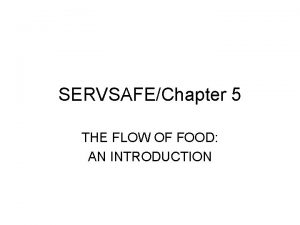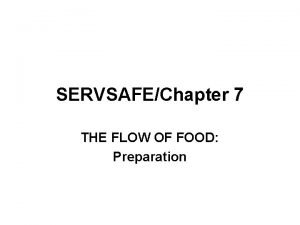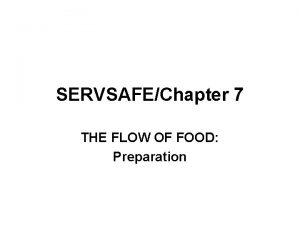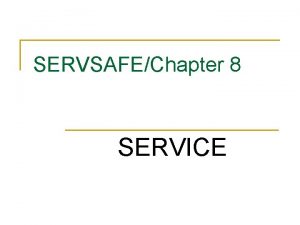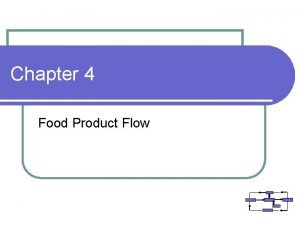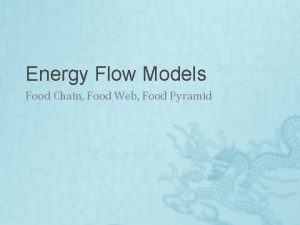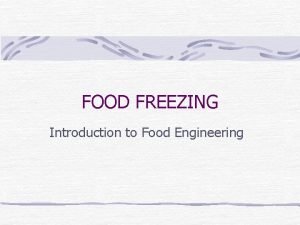SERVSAFEChapter 5 THE FLOW OF FOOD AN INTRODUCTION














- Slides: 14

SERVSAFE/Chapter 5 THE FLOW OF FOOD: AN INTRODUCTION

REMINDERS • TCS food is food that requires time and temperature control for safety • The most basic way to avoid crosscontamination is to keep raw and ready-toeat food away from each other.

Steps in the FLOW OF FOOD 1. 2. 3. 4. 5. 6. 7. 8. 9. Purchasing Receiving Storing Preparation Cooking Holding Cooling Reheating Serving

Ways to PREVENT Cross-Contamination • • • Separate equipment Clean and sanitize Prep food at different times Buy prepared food

DANGER TEMPERATURE ZONE Food Service Industry 41 degrees F. to 135 degrees F. (pathogens grow in this range) 70 degrees F. to 125 degrees F. (pathogens grow faster in this range)

Food is temperature abused when it is… • Cooked to the wrong internal temperature • Held at the wrong temperature • Cooled or reheated incorrectly

How do you AVOID Time-Temperature Abuse? • Monitor when food items should be checked, how often, and by whom • Tools: Make sure the right kinds of thermometers are available • Have foodhandlers record temperatures regularly • Have procedures in place to limit the time food spends in the temperature danger zone • Make corrections when time and temperature standards are not met.

THERMOMETERS • Bimetallic stemmed thermometers • Thermocouples • Thermistors

Types of Thermometer Probes • Immersion: used to check the temperature of liquids such as soups, sauces and frying oil • Surface: used to check the temperature of flat cooking equipment such as a griddle • Penetration: used to check the internal temperature of food like hamburger patties and fish fillets • Air: used to check the temperature inside coolers and ovens

CALIBRATION METHODS • ICE-POINT METHOD 1. Fill a large container with crushed ice. Add tap water until container is full. 2. Put thermometer stem into the ice water. Wait 30 seconds. (Do not let the probe touch the container) 3. Adjust thermometer so it reads 32 degrees F.

CALIBRATION METHODS • BOILING POINT METHOD 1. Bring tap water to a boil in a deep pan 2. Put thermometer stem into the boiling water. Make sure the sensing area is under water. Wait 30 seconds. (Do not let the probe touch the container) 3. Adjust thermometer so it reads 212 degrees F.

Thermometer Guidelines • Thermometers must be washed, rinsed, sanitized and air-dried. • Calibrate thermometers regularly. • Check for accuracy. • Never use glass thermometers to check food temperatures. • When checking the temperature of food, insert the probe into the thickest part of the food


Vo. Cats Questions • To check the temperature of a shipment of MAP, vacuum-packed, and sours vide meats, you should insert thermometer probe between two packages, being careful not to puncture.
 Flow of food steps
Flow of food steps Unit 2 food food food
Unit 2 food food food Eltonian pyramid
Eltonian pyramid Hình ảnh bộ gõ cơ thể búng tay
Hình ảnh bộ gõ cơ thể búng tay Bổ thể
Bổ thể Tỉ lệ cơ thể trẻ em
Tỉ lệ cơ thể trẻ em Voi kéo gỗ như thế nào
Voi kéo gỗ như thế nào Chụp tư thế worms-breton
Chụp tư thế worms-breton Hát lên người ơi alleluia
Hát lên người ơi alleluia Môn thể thao bắt đầu bằng từ đua
Môn thể thao bắt đầu bằng từ đua Thế nào là hệ số cao nhất
Thế nào là hệ số cao nhất Các châu lục và đại dương trên thế giới
Các châu lục và đại dương trên thế giới Công của trọng lực
Công của trọng lực Trời xanh đây là của chúng ta thể thơ
Trời xanh đây là của chúng ta thể thơ
